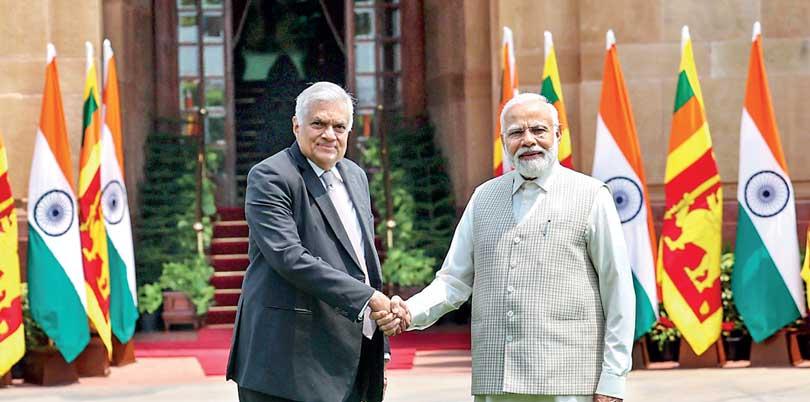22 Jul 2023 - {{hitsCtrl.values.hits}}


During bilateral discussions between President Ranil Wickremesinghe and Indian Prime Minister Narendra Modi yesterday, the two sides agreed to conduct a feasibility study to establish land connectivity between the two countries for developing access to the ports of Trincomalee and Colombo, according to the joint statement.
In the past, a proposal was mooted to construct a bridge linking Tamil Nadu with Mannar based on the ancient Ram Setu or the Adam’s Bridge. However, yesterday’s joint statement published on the website of the Indian External Affairs Ministry does not refer to any revival of such land concavity based on historical links.
According to the statement, the two leaders had productive and outcome-oriented discussions during their interactions in New Delhi. It said the two leaders agreed on connectivity in air, maritime, trade and energy domains.
For the promotion of maritime connectivity, they agreed to cooperate in the development of ports and logistics infrastructure at Colombo, Trincomalee and Kankesanthurai with an aim to consolidate regional logistics and shipping, as per mutual understanding. There is focus to resume passenger ferry services between Nagapattinam in India and Kankesanthurai in Sri Lanka and work towards early resumption of ferry services between Rameswaram and Talaimannar, and other mutually agreed places.
The statement said resumption of flights between Jaffna and Chennai has enhanced people-to-people ties and agreed to further expand it to Colombo as well as explore connectivity between Chennai and Trincomalee, Batticaloa and other destinations in Sri Lanka. The development of the Palali airport is another key area discussed.
Regarding connectivity in the energy sector, the statement said, “That conclusion of MoU on cooperation in developing renewable energy would develop Sri Lanka’s significant renewable energy potential, including offshore wind and solar, thus enabling Sri Lanka achieve its target of generating 70% of power requirements from renewable energy sources by 2030; To establish a high capacity power grid interconnection between India and Sri Lanka to enable bidirectional electricity trade between Sri Lanka and other regional countries, including the BBIN countries, which has the potential to not only bring down the costs of electricity in Sri Lanka but also help create a valuable and dependable source of foreign exchange for Sri Lanka; To expedite implementation of understanding reached on Sampur Solar power project and LNG infrastructure, and explore cooperation in green hydrogen and green ammonia through use of innovative technologies with an aim to increase renewable energy mix in power generation of Sri Lanka.”
It said, “That ongoing cooperation in the development of Trincomalee Tank Farms is a reflection of our endeavour to develop mutually beneficial cooperation projects in Trincomalee area, and agreed to further develop Trincomalee as a national and regional hub of industry, energy and economic activity on the basis of mutual understanding;
To cooperate for construction of a multi-product petroleum pipeline from Southern part of India to Sri Lanka with an aim to ensure affordable and reliable supply of energy resources to Sri Lanka;
To undertake mutually agreed joint exploration and production of hydrocarbons in Sri Lanka’s offshore basins with an aim to develop Sri Lanka’s upstream petroleum sector.
Trade, Economic and Financial Connectivity:
a. That salience of bilateral trade and economic engagements was significantly demonstrated during COVID pandemic and economic crisis of Sri Lanka, and agreed to facilitate mutual investments through, inter alia, policy consistency, promoting ease of doing business and fair treatment of each other’s investors;
b. To facilitate investments from India in the divestment of Sri Lankan State-owned Enterprises and in manufacturing/economic zones in various sectors in Sri Lanka;

c. To undertake discussions on Economic and Technology Cooperation Agreement with an aim to comprehensively enhance bilateral trade and investments in new and priority areas;
d. That decision to designate INR as currency for trade settlements between the two countries has forged stronger and mutually-beneficial commercial linkages and agreed to operationalise UPI-based digital payments for further enhancing trade and transactions between businesses and common people.
e. That India’s rapid digitalisation is an important force-multiplier for ongoing transformational changes in India, both in economic development and governance, and agreed to leverage India’s Digital Public Infrastructure in accordance with Sri Lanka’s requirements and priorities towards effective and efficient delivery of citizen-centric services to the people of Sri Lanka;
People-to-people Connectivity:
a. To promote awareness and popularize India’s Buddhist circuit, and Ramayana trail as well as ancient places of Buddhist, Hindu and other religious worship in Sri Lanka for enhancing tourism;
b. To explore cooperation between educational institutions on both sides including through establishment of new higher education and skilling campuses in Sri Lanka in accordance with Sri Lanka’s requirements and priorities;”
16 Nov 2024 37 minute ago
16 Nov 2024 3 hours ago
16 Nov 2024 5 hours ago
16 Nov 2024 5 hours ago
16 Nov 2024 7 hours ago